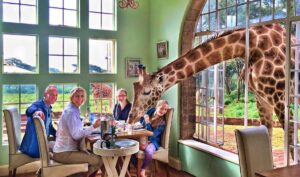Nairobi National Park
Nairobi national Park is an open grassy plain dotted with acacias and man made dams and natural rivers and streams. The Nairobi national park offers a quick and rewarding glimpse into wildlife of Kenya. Four of the big five animals can be found at Nairobi park – The Rhino, Lion, Buffalo and Leopard. Wildlife can be seen stalking through the long grass with the backdrop of the city at the horizon.
Nairobi national park is Kenya First Park established in 1946. The park is best known for its large population of Black Rhino and White Rhino which can be easily seen on a game safari. On the southern boundary is the Athi River, home to crocodiles, Hippo a terrapins. The southern part of the park opens up to the Athi plains where during the July to September window Wildebeest Migrate to this part of the park.
Giraffe Center
The Giraffe center was established in 1983 to protect the Rothschild Giraffe. The center was set up by the African Fund for Endangered Wildlife T(he AFEW). At the time of setting up, there were only 130 Rothschild Giraffe left in the wild in western Kenya and their habitat was constantly shrinking due to heavy cultivation. The Rothschild Giraffe herds were moved to Lake Nakuru National Park, Mwea and Ruma National Park while a dozen were established at the Giraffe center. At the Giraffe center you learn more about these elegant creatures and also get to feed them and observe them at close quarters. The feeding platform also has a lovely view of the Giraffe manor, a luxury hotel which has Giraffe stalking across its lawns. Guides are also available to walk you across the road and into a nature trail and forest.


Elephant Ophanage – David Sheldrick Wildlife Trust
The Elephant Orphanage is set on the edge of the Nairobi national Park, overlooking the vast grassy plains of the park. The Elephant orphanage provides an important refuge for lost orphaned and abandoned baby Elephants. The trusts patient and attentive keepers who are experts at hand rearing wild Elephants and duplicate the natural mother’s role of nurturing and teaching the Elephants how to bathe and use the ears and suckle. Every morning, visitors can watch the baby elephants at play while the keeper narrates the history of each individual Elephant. The Elephants are later released to the wild at Tsavo East National park which involves a process of assisting them acquire a foster family and learn how to survive in the wild. It is an endearing sight to watch the Elephants they trot after the keepers chasing and splashing and being fed from giant milk bottles. On occasion the trust also caters for orphaned Rhinos and other animals.
The Elephant is open during these hours:
1100 HRS to 1200 HRS – Public open Hours
1500 HRS to 1600 HRS – Private Visit
David Sheldrick was the founder warden of Tsavo East National Park when it was established in 1948. He remained the parks warden for 28 years and developed the parks infrastructure for game viewing and water holes for the wildlife. He also embarked on a pioneering study on the behavior of Elephants and was the first person to hand rear Elephants. Since his death in 1977, his wife Daphne has continued to raise and release Elephants and other wildlife to the wild until her demise and her daughter has taken up the management of the orphanage.
The David Sheldrick trust has released over 100 Elephants to the Tsavo national park and continues to promote wildlife conservation worldwide through books, articles, lecture and research.
To plan a safari visit to the Nairobi National Park, Giraffe Center or the Elephant Orphanage please Contact our Kenya Safari advisor for more details and planning
